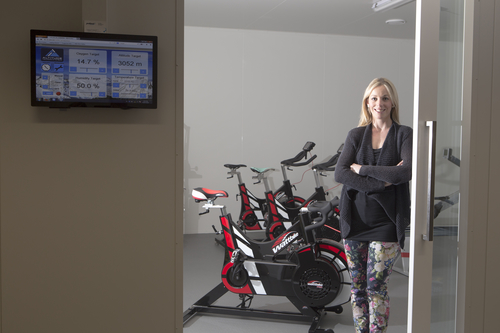Laura Haddock
3 February 2015: For many athletes, training at altitude means spending 2-4 weeks at an altitude of over 2,400 metres above sea level. But what do they do if they are nowhere near a mountain?
University of Canberra sport and exercise science post-doctoral fellow Laura Garvican-Lewis is investigating ways for elite athletes to train in high altitude, as well as hot and humid environments, with the help of a new state-of-the-art environmental chamber at the University of Canberra's Sporting Commons.
"The environmental chamber has the capacity to create hot and humid and/or hypoxic (low oxygen) environments in which to train, so we can try to mimic the environmental conditions of other places around the world. For example, leading into the 2016 Rio Olympics we will be able to recreate similar conditions so athletes can acclimatise at home before they go," Dr Garvican-Lewis says.
"We will investigate how the body responds to these different conditions and also see if there is any benefit to training in different conditions for performance in normal environments."
In the research, which focuses on oxygen-delivery during exercise, Dr Garvican-Lewis says they are finding altitude training is effective because exposure to a low oxygen environment – be it simulated or natural altitude – can induce a number of responses in the human body to help athletes perform later on.
"With elite athletes we are always looking to find that extra performance improvement which can be the difference of getting a medal or not. Altitude training is one way that we might be able to do this," she explains.

|
Laura Garvican-Lewis is using the University's new environmental chamber to help athletes train. |
"Altitude training can make the body generate more red blood cells to carry oxygen. When you return to sea level these extra red blood cells can help an athlete perform better. There are a number of other adaptations which can occur in the muscle too that can help an athlete be more efficient during exercise as well as cope with lactic acid better – both of which would also be beneficial to performance."
Currently there are facilities at the Australian Institute of Sport (AIS) for athletes to live at altitude in their 'altitude house', but the University of Canberra environmental chamber is unique because it provides an environment specific for training and research.
According to Dr Garvican-Lewis, the differences in the way the body adapts to training at altitude are less understood than to the changes experienced from living at altitude.
She says having access to facilities that allow athletes to train and live at high altitudes, in collaboration with the AIS, gives Australian athletes the opportunity to compete on a level playing field with other nations with naturally occurring high altitudes.
"Take distance running for example; the Kenyans are the best in the world. Most of them were born at altitude and grew up living and training at altitude. For Australians to be able to compete with them – when our highest point is only just over 2,000m – is pretty hard. Facilities like
the University of Canberra environmental chamber can bring the mountains to our athletes and help return them somewhat to a level playing ground.
"Ultimately, we're trying to find ways to make athletes go faster."


